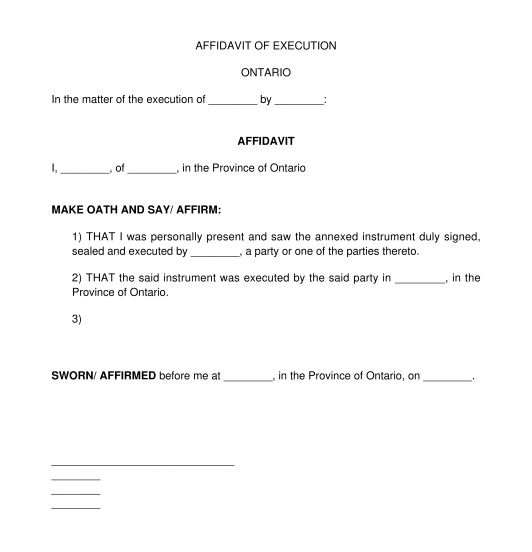 01/10/2025
01/10/2025

Answer a few questions and your document is created automatically.

Your document is ready! You will receive it in Word and PDF formats. You will be able to modify it.

 01/10/2025
01/10/2025
 Word and PDF
Word and PDF
 1 page
1 page
An Affidavit of Execution allows someone to swear they witnessed the signature of a legal document. They swear either under oath or affirmation:
These both have an identical legal effect, the breach of which is the criminal offence of perjury, which could lead to imprisonment.
Specifically, the Affidavit of Execution is needed when someone executes (signs) a legal document and the document is witnessed. Witnessing means seeing the person sign the legal document, and the witness then signs the legal document themselves. If the witness signed the legal document, they would sign the Affidavit of Execution. Once the Affidavit is signed, a Commissioner or Notary signs the Affidavit. These are people authorized by law to witness Affidavits, which is a requirement. A simple Google search can be used to locate a local commissioner or notary.
This document is for an affidavit of execution. Other affidavits may be used depending on the legal context. For example, a general affidavit may be used to recount a set of facts.
HOW TO USE THIS DOCUMENT
After witnessing a person sign a legal document, the Affidavit of Execution is then signed by the person who witnessed the signature on the legal document. Witnessing means the witness was physically present and saw the person sign the legal document in front of them.
Once the witness signs the Affidavit, a commissioner for oaths and affidavits must also sign (commission) the document to verify the authenticity of the statement. Notaries are also authorized to commission these documents.
In short, the process is the following:
The Affidavit must be signed in front of a Commissioner or Notary. If the Commissioner or Notary isn't present, print out the document and wait to sign it in the presence of the Commissioner or Notary. Some Provinces and Territories permit remote signing.
APPLICABLE LAW
Affidavits are used depending on the legal context. For example, when dealing with a lawsuit, the law requires the filing of Affidavits with the court. When dealing with a deceased's estate, the law requires the filing of an Affidavit of Execution to probate (prove) the Will of the deceased. An Affidavit is also used when changing a marital name or transferring title to property. The affiant in an Affidavit must be honest when recounting the facts. Lying under oath or affirmation is a federal crime under the Criminal Code (R.S.C., 1985, c. C-46).
HOW TO MODIFY THE TEMPLATE
You fill out a form. The document is created before your eyes as you respond to the questions.
At the end, you receive it in Word and PDF formats. You can modify it and reuse it.
Affidavit of Execution - Template - Word & PDF
Country: Canada (English)